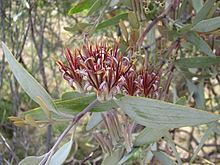Rank Species | ||
 | ||
Similar Amyema, Amyema pendula, Amyema preissii, Lysiana exocarpi, Amyema congener | ||
Amyema quandang is a species of hemi-parasitic shrub which is widespread throughout the mainland of Australia, especially arid inland regions, sometimes referred to as the grey mistletoe.
Contents
Description
An aerial shrub, without conventional roots, which attaches to the stems of species of Acacia. The leaves are leathery and greyish, and lanceolate to broadly ovate. Flowers are red, green and grey and appear sometime between April and October. The fruit is a fleshy drupe, between 6 and 10 millimetres long, that contains an oily seed.
Ecology
The plant has a hemi-parasitic relationship with Acacia, it is recorded on: A. aneura, A. cambagei, A. papyrocarpa, A. omalophylla and A. dealbata.
Two species of birds are noted for their interdependence, or mutualism, where they occur with A. quandang in the arid interior of Australia. Nectar from the species provides an important part of the diet of spiny-cheeked honeyeaters Acanthagenys rufogularis, who assist in its pollination. The fruit is consumed by mistletoebirds, Dicaeum hirundinaceum, who disperse the seed; the year round availability of the fruit is ignored by other frugivores.
The hybridisation of this species with Amyema pendulum, rare amongst Loranthaceae, has produced first generation hybrids.
Taxonomy
A member of Santalales, the mistletoe order, placed within the Loranthaceae family. The first publication of the species was made in a note by John Lindley in 1838, describing the plant noted by Thomas Mitchell as growing on Santalum acuminatum, another hemiparasite known as quandong.
May 9. We moved to the pond above-mentioned, named Yambarenga ... and in some
places I observed the Quandang bushes,* having their branches covered with a parasitical plant whose bright crimson flowers were very ornamental.**
(*Footnote. Fusanus acuminatus.)
— Lindley, Mitchell, 1838
The description in the genus Loranthus remained until Philippe Édouard Léon Van Tieghem transferred it to the genus Amyema in 1894. The genus name is derived from Greek for 'without' and 'to instruct'.
Two varieties of the species are described, Amyema quandang var. quandang and Amyema quandang var. bancroftii (F.M.Bailey) Barlow, the latter being found in Queensland and New South Wales.
